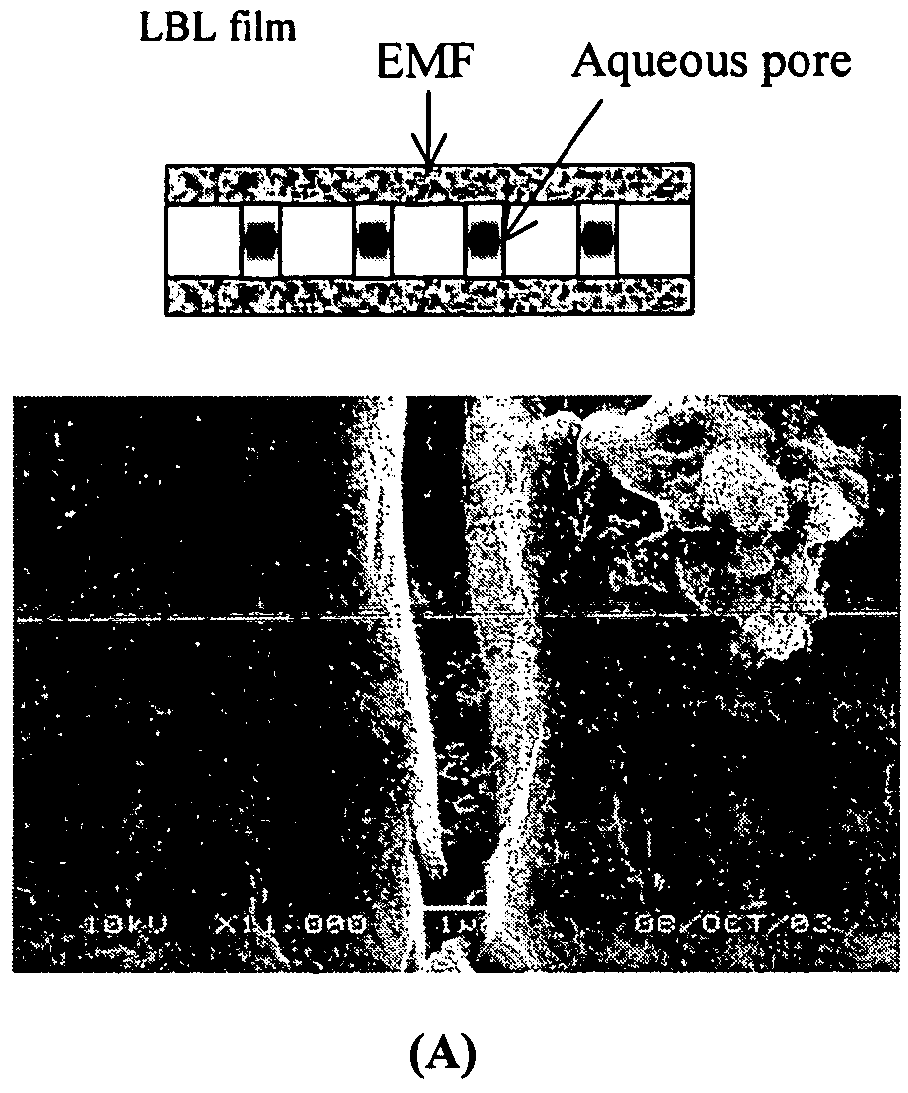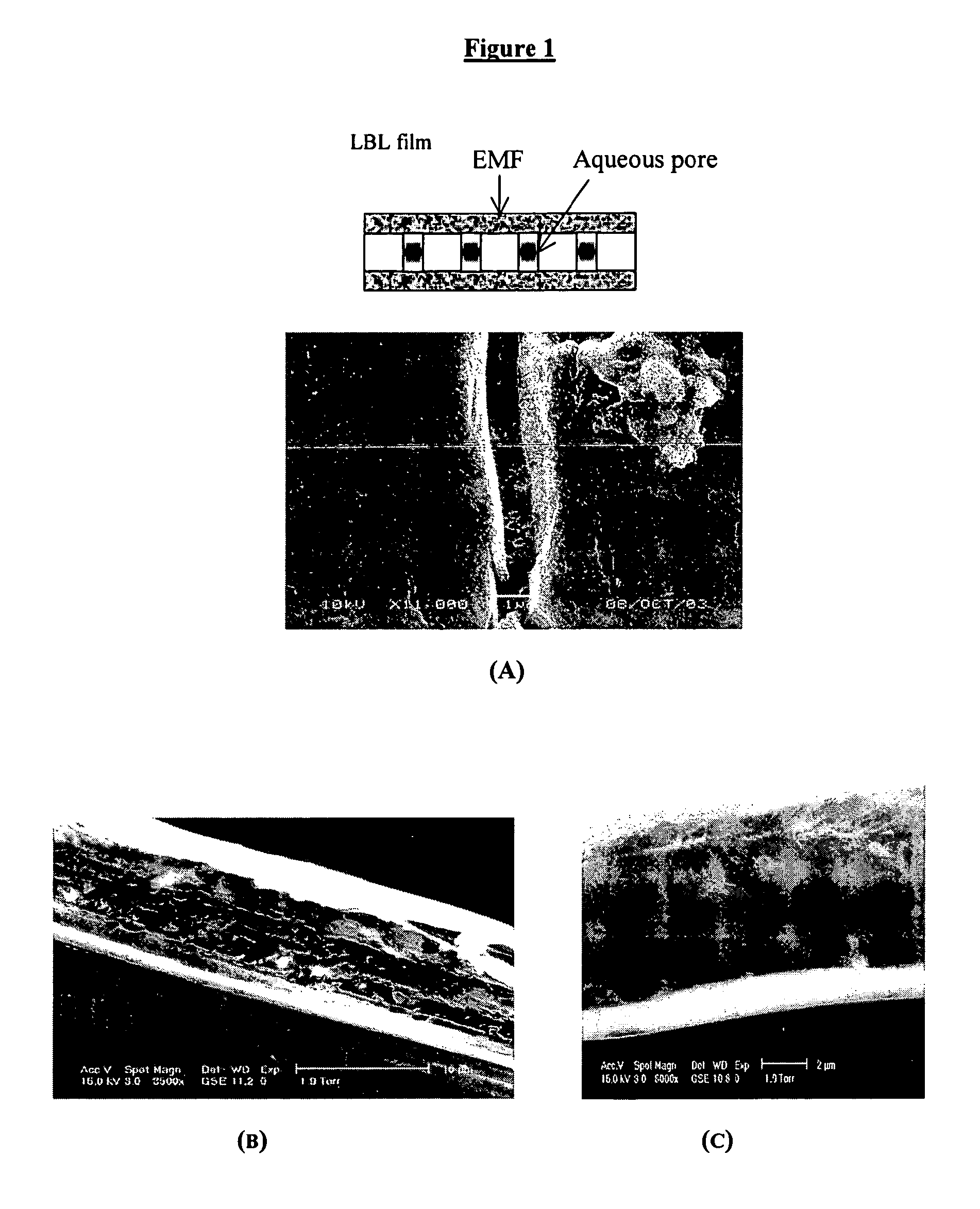Carbon-Polymer Electrochemical Systems and Methods of Fabricating Them Using Layer-by-Layer Technology
a technology layers, applied in the field of carbon-polymer electrochemical systems, can solve the problems of fuel cell voltage outputs that are less than ideal, decrease with increasing load, and increase in recent applications
- Summary
- Abstract
- Description
- Claims
- Application Information
AI Technical Summary
Benefits of technology
Problems solved by technology
Method used
Image
Examples
example 1
Membrane Preparation
[0204]All polyelectrolytes used to fabricate the LBL films were used as received. Poly(styrene sulfonic acid, sodium salt) [PSS; MW=70,000], Poly(diallyldimethyl ammonium chloride) [PDAC; MW=240,000], Linear Poly(ethyleneimine) [LPEI; MW=25,000], Poly(acrylic acid) [PAA; MW=90,000], Poly(styrenesulfonic acid-maleic acid, sodium salt) [PSSM3:1; MW=20,000], Poly(ethylene oxide) [PEO; MW=4,000,000], Poly(methylacrylic acid) [PMAA; MW=100,000], Poly(acrylic-co-acrylamide acid, sodium salt) [PAAcoAAm, MW=10,000,000 40% carboxy], all from Polysciences Inc. Poly(2-acrylamido-2-methyl-1-propane sulfonic acid) [PAMPS; MW=2,000,000], Poly(dimethylamine-co-epichlorohydrin) [PDME], and Polyaniline (Emarlidine base) [PAN, MW=100,000], from Aldrich. Nafion117 as a 5% resin solution from Fluka. Sodium chloride from Mallinckrodt C.P., Sulfuric acid 98%, Nitric acid 96.6%, 30% hydrogen peroxide from Fischer.
[0205]Nucleopore® membranes (25 mm diameter) were from SPI supplies. Nafi...
example 2
[0207]The “composite membranes” were soaked in 20.0 mM sulfuric acid solution for 20 minutes then placed on permanox slides ready to be folded between the ELAT C / Pt electrodes. All the “composite membranes”, including the Nafion112, were moderately hand pressed to the electrodes at room temperature. The untreated electrodes were twice soaked in 2.5% Nafion117 solution for 15 minutes and oven dried at 90° C. for 3 minutes.
[0208]The Nafion112® was pretreated by heating at 80° C. with 2% H2O2 solution for 2 hours followed by rinsing with Milli-Q pure water. The Nafion membrane was then soaked in a 0.5M sulfuric acid solution for two days and then boiled in 20 mM sulfuric acid solution for 1 hour before storing in pH=1.7H2SO4 solution. Slade, S.; Campbell, S. A.; Ralph, T. R.; Walsh, F. C. J. Electrochem. Soc. 2002, 149, A1556-A1564.
[0209]The MEA was fitted inside a fuel cell module that acts as bipolar plates but with no serpentine channels that provide intimate fuel ...
PUM
| Property | Measurement | Unit |
|---|---|---|
| thickness | aaaaa | aaaaa |
| humidity | aaaaa | aaaaa |
| Area | aaaaa | aaaaa |
Abstract
Description
Claims
Application Information
 Login to View More
Login to View More - R&D
- Intellectual Property
- Life Sciences
- Materials
- Tech Scout
- Unparalleled Data Quality
- Higher Quality Content
- 60% Fewer Hallucinations
Browse by: Latest US Patents, China's latest patents, Technical Efficacy Thesaurus, Application Domain, Technology Topic, Popular Technical Reports.
© 2025 PatSnap. All rights reserved.Legal|Privacy policy|Modern Slavery Act Transparency Statement|Sitemap|About US| Contact US: help@patsnap.com



